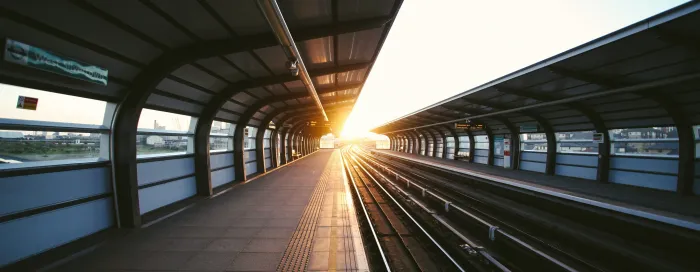Europeans are facing an unprecedented rise in the price of petrol. It is extraordinarily difficult for the European Union to organise a reliable system to import the raw materials essential to its economy from Ukraine. The climate crisis is obliging us to speed up the green transition. Faced with all these challenges, the European Union must take action in a range of areas. There is, however, one sector that can provide many answers to these challenges: transport.
What is the role of trans-European transport networks?
Trans-European transport networks (TEN-T) are the European Commission's strategic policy with which it aims to reduce greenhouse gas emissions from the European transport system, alongside the Connecting Europe Facility (CEF), with its military mobility aspect, which has a budget of EUR 25.81 billion over seven years (2021-2027) for transport. TEN-Ts also aim to guarantee multimodality and interoperability between different modes of transport, in particular by better integrating urban nodes in the network and removing bottlenecks, making the transport system more resilient to climate change, wars or natural disasters and strengthening governance.
In practical terms, this means that TEN-Ts support the modal shift from the most polluting modes (airplanes and cars) to the least (rail and maritime) and that they should include regional authorities more in the governance of transport policy in Europe.
Trans-European transport networks are thus at the same time a territorial cohesion issue, a means for the European Union to achieve carbon neutrality by 2050 but also, more recently, an instrument to make the continent more resilient to the multiple crises it is facing.

Source: European Commission
"Building bridges" across borders
It's no coincidence that the 50 euro note has an image of a bridge on it. The idea of building bridges across borders has always been at the heart of the European project. The trans-European transport network policy does this literally: it builds bridges or, more often these days, tunnels to cross borders and connect territories that would have remained on the periphery, enclosed within their own country, and which become more central when the border is no longer a barrier but an opportunity.
In these times of crisis, the trans-European network policy therefore brings cohesion to the European continent. For example, the Pyrenees are still the most difficult French land border to cross. While there is a glut of Atlantic and Mediterranean coastal corridors, there has been little progress in high-speed rail crossing projects in the mountain range. Given the disengagement of the State, both in Spain and France, increasing involvement of the regions and the European Union via TEN-Ts can give us hope that we will be able to go further in connecting our territories.
Territorial cohesion is one of the primary objectives of trans-European transport networks, guaranteeing accessibility and connectivity of all regions of the European Union, particularly peripheral and outermost regions. At the same time, this connectivity is a factor for economic development and competitiveness.
In addition, TEN-T policy supports the European Union's efforts to slow the pace of climate change while improving the quality of life of its inhabitants. In the field of transport, the European Green Deal calls for a 90% reduction in greenhouse gas emissions from transport to achieve carbon neutrality. And without the trans-European transport networks, there is no modal shift away from road transport, with all its negative effects in terms of pollution, congestion and accidents, towards more virtuous modes such as rail.
Trans-European transport networks increasingly offer an alternative to air transport, such as high-speed trains or night trains, which explains why the Connecting Europe Facility (CEF) devotes a very large part of its funds to the development of rail, particularly high-speed rail.
Finally, with the trans-European transport networks, the European Union aims to make the continent more resilient to crises. During the COVID-19 crisis and the closure of national borders, it was the green corridors, built on TEN-T infrastructure, that allowed Member States to continue to exchange goods and avoid stock disruption. Today, it is the cross-border interconnections with Ukraine that the European Commission wants to strengthen to organise the transfer of goods and materials that have been blocked in Ukraine and are essential to the European economy.
PES Group member Isabelle Boudineau, member of the Regional Council of Nouvelle-Aquitaine (France) and Committee of the Region's rapporteur on the "Guidelines for the development of the trans-European transport network (TEN-T)" rightly points out that "The difficulties in importing wheat and raw materials, currently stuck in Ukraine, demonstrates that establishing an efficient European transport system is more than an economic need; it is a necessity in terms of European sovereignty. This is why it is imperative to complete the TEN-T by developing cross-border transport projects. We need to improve and better integrate urban nodes into the transport system, to make free movement of persons and goods a reality for all."
Loin d’être une politique technique, la politique des réseaux transeuropéens est une politique vitale à l’avenir de l’UE. Il est donc indispensable que les régions soient parties prenantes de la gouvernance de cette politique. @IBoudineau @PES_CoRhttps://t.co/zIWrbne4zy
— Sauvons l'Europe (@sauvonsleurope) October 24, 2022
Regions as indispensable partners
Far from being just a technical policy, the trans-European network policy is a vital policy for the future of the European Union. Therefore, it is essential that regions be involved in the governance of this policy. It is the regions that have the power to connect all residents of Europe, in their mountains, in their villages, in their towns and on their coasts, to the promise of freedom of movement that the European Union offers. They can also connect these major European corridors to everyday mobility to ensure that every day, from the first to the last kilometre, every European has the opportunity to choose cleaner mobility that will protect our children's future.
© Photo credits: Charles Forerunner on Unsplash
